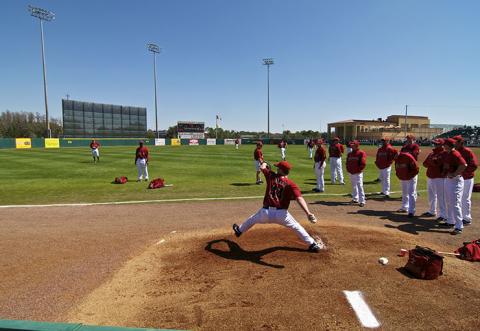
It seems as though America’s pastime is on its way to becoming a little safer for those who pitch. There has been a renewed focus on pitch count associated with baseball and softball. The research is skewed toward baseball and the throwing mechanics associated with pitchers. Softball pitching is also being investigated as well, but it seems that the mechanics associated with the underhand release is less harmful to the human body than the overhead release. As stated earlier “it seems” like steps are being taken. If nothing else, awareness and education has been enhanced. While reducing the number of pitches thrown by pitchers in either sport seems like a good choice, the research has not concluded as such. The future will prove whether or not the reduction in innings or pitches thrown will have a positive effect on student athletes.
Many states adopting pitch counts also require specific rest periods. Some states rely on the school principal to determine the pitching rules for their state. Another state only has rules that apply for post-season play. Still another restricts based on the number of outs. This particular rule would allow 180 pitches in 10 innings, or three appearances in a week, with no rest required. While we are making headway to protecting our athletes we still have a ways to go.
Currently there are states that are taking a very strong stance and have attempted to restrict the younger players at the lower levels more than the older pitchers. This may seem like a wonderful idea, but they forgot to address mandatory days of rest. To parents and coaches these changes seem like the ticket to a safer game, prolonged involvement by their players and a potential reduction in injuries. Unfortunately, they are only the start.
I contacted a researcher who is passionate about the sport of baseball and is also an athletic trainer, his work will certainly help us to make more clinically proven or what some would call data driven decisions moving forward. Below is a blog written by Samantha May, undergraduate research assistant; Michael McNally, doctoral student; and James Onate, associate professor and director of Research Laboratory of the MOVES Research Laboratory at Ohio State University:
If an athlete is throwing too hard, too often, too early on, and without adequate rest, a serious injury to the throwing arm may be on the horizon. Such injuries may include problems in the shoulder, upper arm, elbow, forearm, or wrist that are associated with pain, stiffness, swelling, instability, “giving way,” locking, and other complaints related to the throwing arm. The proposals by the USA Baseball Medical and Safety Advisory Committee and other organizations have brought awareness to the need for decreasing arm injuries in adolescent baseball pitchers; but results from present studies have illustrated that a significant number of serious shoulder and elbow injuries among high school pitchers still exist.
While overuse is thought to be a common denominator in the evaluation of baseball players with overhead injuries, not everything is so black and white. At this time, there is little to no research evidence supporting current specific safety recommendations on pitch counts for adolescent pitchers. Without a highly valid and reliable method of objectively collecting and analyzing data across all ages, it is difficult to identify and investigate injury thresholds in throwing-dominant sports. Some preventative measures may include proper warm-up, good control and mechanics, regular communication with the sports medicine staff, and/or avoiding pitching on consecutive days; but there is still no “magic number” assigned to maximum pitch counts, amount of rest periods, or limitations for various types of pitches.
Current literature places emphasis on the relationship between workload and injury, but only total workload has been examined – not the intensity and performance aspects of the workload. With personal surveys and questionnaires being the main methods of data collection from each individual athlete (either on a daily, weekly, or monthly basis), there are many chances for researcher and respondent bias – as well as random and systematic error. Furthermore, there are too many differences in chronological and training age; and the inconsistencies in injury definitions and time frames utilized for observation and monitoring have made the research process even more complicated. In order to explore and better understand the mechanisms of soreness, pain, and injury (and corresponding safety recommendations and/or regulations for those injuries) in young baseball pitchers, a standardized protocol/system needs to be created and implemented at all levels of play – specifically one with minimal subjectivity and high content, face, and construct validity.
References
Black GM, Gabbett TJ, Cole MH, Naughton G. Monitoring Workload in Throwing-Dominant Sports: A Systematic Review. Sports Medicine. 2016 Oct 46(10):1503-1516.
Olsen SJ, Fleisig GS, Dun s, Loftice J, Andrews JR. Risk Factors for Shoulder and Elbow Injuries in Adolescent Baseball Pitchers. American Journal of Sports Medicine. 2006. Jun 34(6):905-912..
Yang J, Mann BJ, Guettler JH, Dugas JR, Irggang JJ, Fleisig GS, Albright JP. Risk-Prone Pitching Activities and Injuries in Youth Baseball: Findings from a National Sample. American Journal of Sports Medicine. 2014. Jun 42(6):1456-1463.





